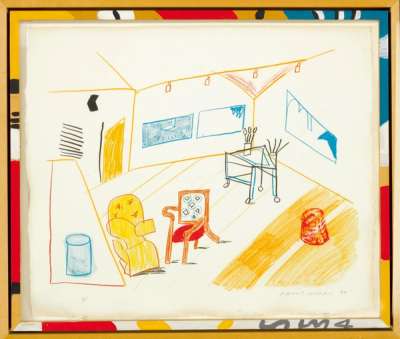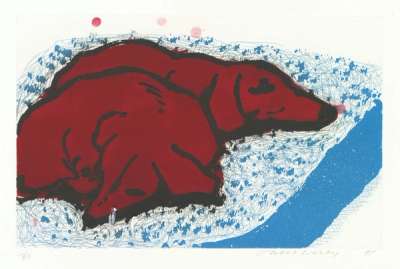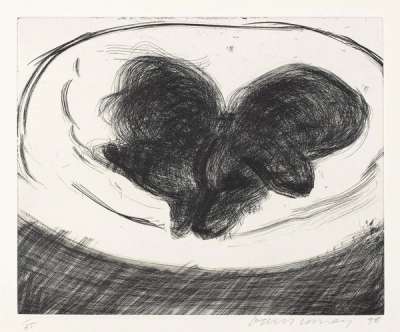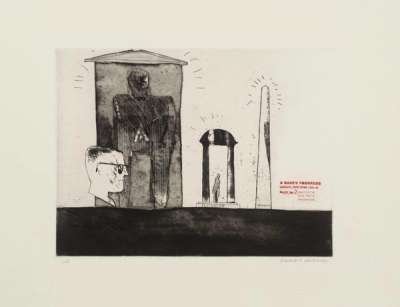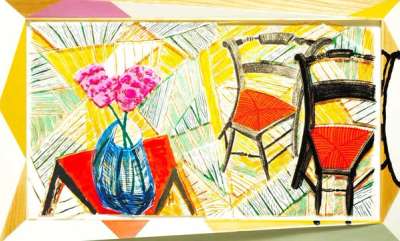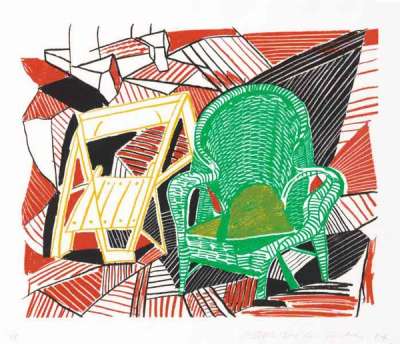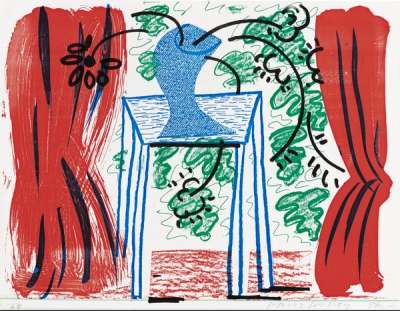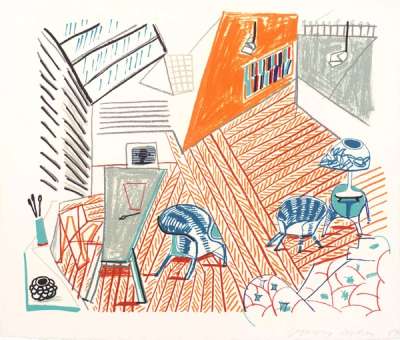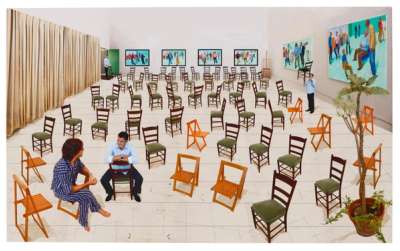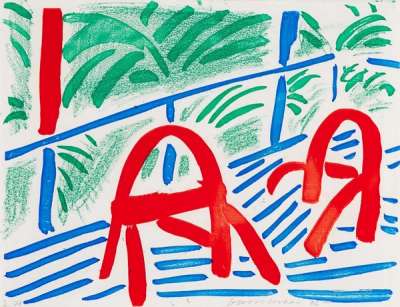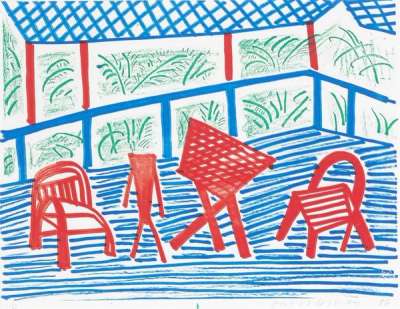 Number One Chair © David Hockney 1986
Number One Chair © David Hockney 1986
David Hockney
654 works
In art, furniture has consistently acted as a conduit for expressing complex ideas and emotions. David Hockney's exploration of chairs provides a fascinating lens through which to view this phenomenon. Through his works Hockney transforms the mundane chair into a powerful symbol of presence, mood and the passage of time. By positioning chairs not just as objects within a space but as central elements of his compositions, he invites the viewer into a dialogue with the unseen and the unsaid. Hockney's adept use of chairs as narrative devices in his art underscores his innovative approach to storytelling through visual means.
 Gentlemen Smoking And Playing Backgammon In a Tavern © Dirk Hals 1627
Gentlemen Smoking And Playing Backgammon In a Tavern © Dirk Hals 1627A Brief History of Furniture in Art
Furniture in art has been a symbolic and thematic presence across centuries, serving as more than mere backdrop or decoration – rather, it often embodies the essence of an era, reflecting the artist's emotional state or symbolising broader cultural themes. It has been prevalent as far back as ancient history, when Egyptian tomb paintings and Greek vases depicted furniture to signify status, power or divine connection. During the Renaissance, furniture in art became more detailed and realistic, with artists like Jan van Eyck incorporating it to enhance the narrative depth and perspective of their works and demonstrate their technical dexterity. The Dutch Golden Age brought an intimate portrayal of domestic interiors, with artists like Johannes Vermeer and Pieter de Hooch using furniture to create serene, light-filled scenes that speak to the tranquillity of everyday life. These pieces often carried moral or allegorical messages, conveyed through the careful arrangement of household objects. Many chairs can be seen in Dirck Hals’s genre scene of Gentlemen Smoking And Playing Backgammon in A Tavern, for example.
In the 19th century, the focus shifted towards more personal and emotional expressions. Vincent van Gogh's The Bedroom is a prime example, where his simple, yet vibrant depiction of his bedroom in Arles goes beyond the physical space, reflecting his quest for peace and stability. Van Gogh also painted a series of chairs, including Van Gogh’s Chair, which Hockney would reimagine a century later. The 20th century introduced abstract and conceptual approaches to furniture in art, as Surrealists like Salvador Dalí took furniture to the realm of the uncanny, transforming everyday objects into dreamlike symbols, as seen in his Mae West Lips Sofa. Contemporary artists continue to explore furniture's thematic and aesthetic potential, using it to address issues of identity, consumerism, and the passage of time. In Marina Abramović's performance piece The Artist Is Present, chairs played a crucial and symbolic role in the interaction between the artist and her audience. Held at the Museum of Modern Art in New York in 2010, the piece featured Abramović sitting silently at a wooden table for 736 hours across three months, inviting museum visitors to sit opposite her and share a moment of silent interaction. The chair opposite Abramović became a stage for a profound, non-verbal dialogue, serving as a vessel for emotional exchange and human connection.
Hockney's work, therefore, follows a long tradition in depicting these beloved everyday objects.
Chairs as Subjects
One of Hockney’s earliest depictions of a chair is Panama Hat On A Chair With Jacket, from 1972. This work is a poignant visual tribute following the death of his friend and the first curator of 20th-century art at the Metropolitan Museum, Henry Geldzahler. Through the intimate arrangement of Geldzahler's personal items – a Panama hat, a jacket, an empty glass, and a pipe on one of Hockney's signature chairs – the artwork transcends a simple still life, evolving into a profoundly rhetorical portrait without depicting Geldzahler himself. The presence of his objects without the physical presence of the person is deeply felt, and grief permeates the composition. Hockney revisited this work in 1998 with Hat On A Chair and Panama Hat On A Chair, created by Hockney to appear in the Geldzahler Portfolio: a collection of 10 works by artists such as Jasper Johns, Roy Lichtenstein, David Salle, and Frank Stella.
In 1973, Hockney created two lithographs from his home in California, Chair, 38 The Colony, Malibu and Slightly Damaged Chair, Malibu. With a keen eye for the subtle imperfections and folds on the chairs, Hockney employs a delicate touch that highlights the details and nuances of an everyday household item, transforming it into a subject of deeper observation and appreciation. In direct contrast to the vibrant colour palette that dominated his most famous works at the time – including Portrait Of An Artist (Pool With Two Figures) – the greyscale used here forces the viewer to focus solely on the object, removed from any context.
By the 1980s, however, Hockney was turning to using colour in depicting chairs, doing so in a style that was completely different from the photorealism of before. In Two Pembroke Studio Chairs, the pieces of furniture are depicted in contrast to an abstracted Cubist backdrop. In Two Red Chairs and Two Red Chairs And Table he explores a more modernist technique, with a primary colour palette. In Picture In Two Chairs he takes a more subdued approach, choosing warm colours to create a cosy environment, while Number One Chair distinguishes itself entirely from its surrounding through colour. The 1988 work Office Chair takes a flat, minimalist approach – although it retains Hockney’s preference for primary colours.
In the work Chair With Book On Red Carpet from 1999, Hockney had returned to his original approach, using grayscale with touches of red, reminiscent of his style in The Rake’s Progress series. Throughout these works, the chair has operated as a subject in itself. It has been modified in accordance with Hockney’s purposes and styles, showing how versatile both the object and artist are.
Chairs as Artistic Inspiration and Instruction
For Hockney, chairs have also served as vehicles for exploring broader artistic themes such as perspective, artistic homage, and the dialogue between past and present. This is evident in The Perspective Lesson and Van Gogh Chair, each offering a distinct take on the role of chairs as both inspiration and instructional tools in art. Both works seek inspiration from the same source, Van Gogh’s Chair, by the post-Impressionist master. The Perspective Lesson is a compelling demonstration of Hockney's interest in the mechanisms of seeing and representing space, and cleverly engages with the concept of perspective – a foundational element of art historical tradition. Hockney not only challenges traditional notions of perspective and depth but also invites the viewer to reconsider the way everyday objects can be viewed and depicted. The chair, in this context, becomes a symbol of the artist's inquiry into the nature of visual representation, serving as both the subject of the lesson and a metaphor for the viewer's engagement with space and perspective.
In Van Gogh Chair, Hockney pays direct homage to van Gogh’s work, celebrating the emotional and expressive potential of colour and brushwork that characterises his style. Hockney's choice to depict the chair — a simple, everyday object that Van Gogh imbued with profound significance — underscores a shared interest in exploring the emotional and symbolic dimensions of the mundane. Through this homage, Hockney connects his artistic practice with the larger art historical narrative, acknowledging the influence of past masters while asserting his own creative vision.
Chairs as Props
Chairs also serve as significant props in Hockney's oeuvre, often acting as vital elements that contribute to the narrative, composition and emotional depth of his works. Hockney's fascination with chairs can be seen in several of his portraits, where they do not just support his subjects physically but also add layers of meaning, context and personality to his portrayals. Many of these feature his muse and frequent subject of his art, Celia Birtwell: in Celia In A Wicker Chair and its counterpart Celia In A Wicker Chair (black state), Hockney captures her seated in a woven chair. The choice of a wicker chair in these works is particularly telling; its open, airy design contrasts with the solidity of the sitter, highlighting her presence and the gaze she offers the viewer. The chair frames Birtwell in a way that emphasises her elegance and the casual grace of the moment, merging the domestic with the artistic. Celia Seated In An Office Chair and its black state counterpart presents a different mood: the office chair, typically associated with work and formality, echoes her straight posture and suggests a blend of personal and professional realms. Hockney's ability to depict the chair with such fidelity, alongside his subject, underscores his interest in the textures, forms, and functional aspects of chairs as objects in space.
Celia In Director’s Chair and Ann Seated In Director's Chair offers yet another perspective. The director's chair, often linked with authority, frames the women in a position of casual command. The choice of this chair signifies a playful nod to roles of leadership and creativity, elements that resonate throughout Hockney's career. By placing the subjects in this chair, Hockney not only captures their physical likeness but also hints at their personality and dynamic. The chair, with its emblematic association with direction and creativity, underscores the women’s role as muses and collaborators in Hockney's creative process. The setting and posture convey a sense of comfort and ease, highlighting the intimate and personal connection between artist and subject.
In Celia Adjusting Her Eyelash, although the focus is mainly on the act depicted, the chair again plays an essential role in framing the moment. The chair supports the action, providing a stage for the intimate gesture of adjusting an eyelash. This work exemplifies how Hockney uses the interaction to draw attention to the mundane yet deeply personal moments that often go unnoticed. The chair, in this instance, is not just a physical object but a symbolic one, emphasising the casual elegance and poise of the subject, even in a moment of unguarded vulnerability. Similarly, in Celia In An Armchair she is seated comfortably in an armchair, a setting that immediately conveys a sense of intimacy and relaxation. The chair frames Birtwell in a personal and private moment, suggesting a space of ease while emphasising the sitter's elegance and the quiet strength of her personality, as well as the close relationship between the artist and his muse.
Through these works, Hockney explores the chair as a marker of the sitter's mood and relationship with their surroundings.
Chairs as Narrative Devices
Occasionally, Hockney also utilises chairs as narrative devices, imbuing them with a narrative significance that extends beyond their utilitarian function and transforming them into symbols of presence, absence, and the passage of time. Two notable works where Hockney employs them to craft narrative are Celia With Chair and The Chairs. In the former, he shows an easel with a painting of a close-up of Birtwell’s face, positioned across from a chair in an otherwise vacant room. In this configuration, the chair and the easel with Celia's portrait interact within the space, creating a dialogue between presence and absence, the mechanism of painting and the viewer, the tangible and the represented. The chair, facing the easel, suggests an audience to the portrait, implying a presence that is felt rather than seen. This setup narrates a story of anticipation or reflection, speaking to the idea of absence being as potent a presence within a space as the physical presence of an individual.
In The Chairs photo collage, Hockney departs from traditional single-point perspective to offer a multifaceted view of a scene composed of multiple chairs. The chairs are arranged in such a way that they invite the viewer to consider the stories they might tell — who sat in them, what conversations took place, or what moments of solitude they witnessed. Were they ever full? Why are they empty? The technique allows Hockney to play with space, time and perspective, creating a narrative that is fragmented yet cohesive. The chairs come together to form a collective narrative about presence, absence and the passage of time.













